Land Invertebrates
Media

Species Types
Scientific Name
About 300 species in North America north of Mexico
Description
People notice spider wasps when they notice a female lugging a captured spider to its doom. In most cases, she will drag the spider into a burrow, lay an egg on the spider, and then hunt for more spiders!
Media
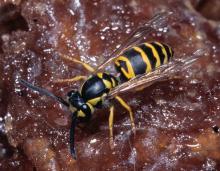
Species Types
Scientific Name
Vespula spp.
Description
Yellowjackets are bee-sized social wasps that build paper nests, usually underground. Their defensive stinging can make them a major pest when they nest near people.
Media
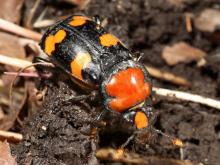
Species Types
Scientific Name
Nicrophorus americanus
Description
The American burying beetle is endangered statewide and threatened nationally. Restoration efforts are under way. This brightly patterned beetle specializes in cleaning carrion from the landscape, burying dead mice, birds, and other creatures.
Media
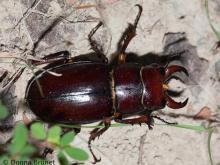
Species Types
Scientific Name
About 40 species in North America north of Mexico
Description
Stag beetles are a family that, though not very colorful, have prominent pincers! Male stag beetles usually have enlarged, sometimes astonishing jaws. These “antlers” give rise to the common name.
Media

Species Types
Scientific Name
More than 400 species in North America north of Mexico
Description
The name is a warning: blister beetles are famous for their chemical defenses. Beetles in this family can exude an oil that can cause a person’s skin to blister.
Media
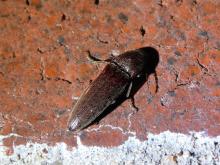
Species Types
Scientific Name
Approximately 1,000 species in North America
Description
Their streamlined shape is distinctive, but the behavior of click beetles is even more unique: Placed on their backs, these beetles flip suddenly into the air with an audible click.
Media

Species Types
Scientific Name
Approx. 175 species in North America north of Mexico
Description
Fireflies are amazing beetles that use “cold light” (bioluminescence) to attract mates. They are commonly seen as they fly and glow in summer evenings.
Media

Species Types
Scientific Name
Boisea trivittata
Description
Notoriously numerous, boxelder bugs overwinter in nooks of tree bark and rocks, but they will settle for warm crannies of your house. The box elder tree is the food plant of this harmless insect.
Media
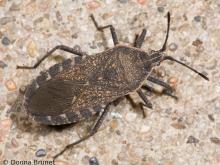
Species Types
Scientific Name
Anasa tristis and other Anasa spp.
Description
Sooner or later, most Missouri gardeners learn about squash bugs, which feed on the foliage of squash, pumpkins, melons, cucumbers, and other plants in the squash family.
Media

Species Types
Scientific Name
Nearly 500 species in North America north of Mexico
Description
Soldier beetles are most often seen on flowers. Many species in this family are pollinators. Yellow, orange, and red are their most common colors, besides black and brown.
See Also



Media

Species Types
Scientific Name
Cisseps fulvicollis
Description
The yellow-collared scape moth is more often “orange-collared.” And whether you think it looks more like a firefly or a wasp, it’s still a moth!
Media

Species Types
Scientific Name
Nearly 150 species in North America north of Mexico
Description
Slim, delicate plume moths are instantly recognizable by their T-shaped silhouette, long legs, and muted shades of tan and brown. It can be hard to separate the various species.
Media

Species Types
Scientific Name
Pyrrharctia isabella
Description
Not many people know the adult Isabella tiger moth when they see one, but we’re all acquainted with its caterpillar, the woolly worm, or woolly bear.
About Land Invertebrates in Missouri
Invertebrates are animals without backbones, including earthworms, slugs, snails, and arthropods. Arthropods—invertebrates with “jointed legs” — are a group of invertebrates that includes crayfish, shrimp, millipedes, centipedes, mites, spiders, and insects. There may be as many as 10 million species of insects alive on earth today, and they probably constitute more than 90 percent all animal species.





















